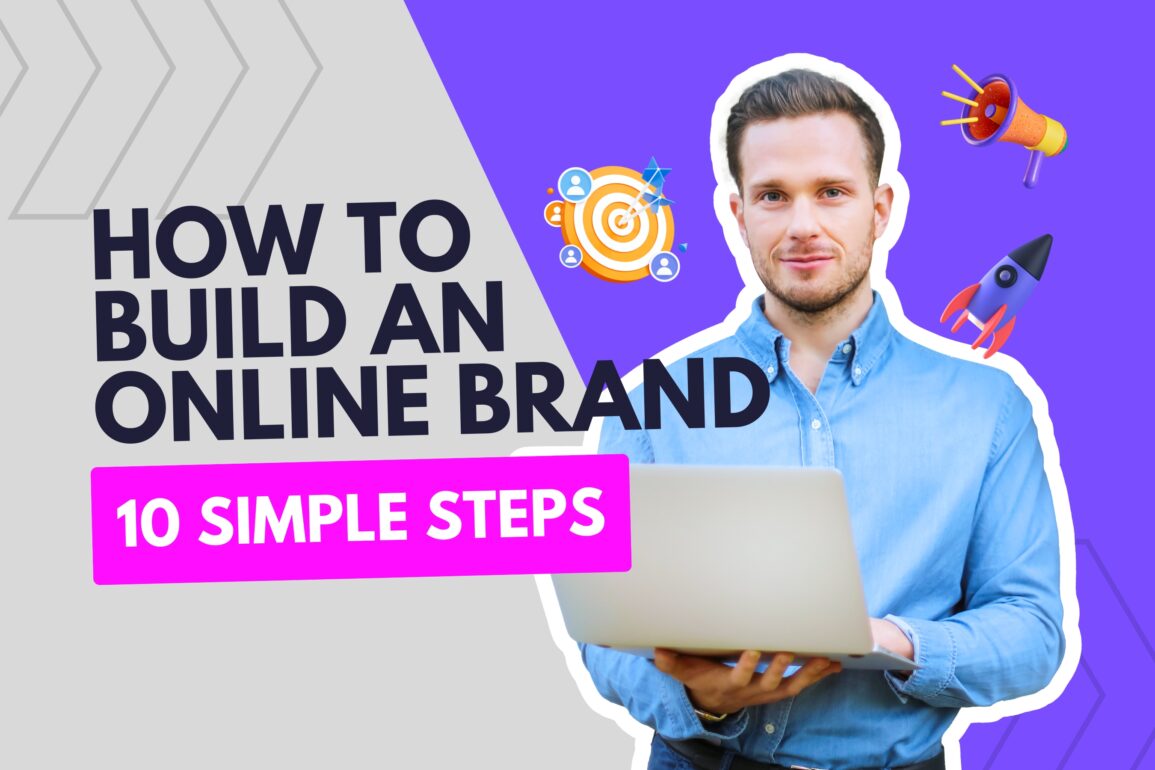How to build an online brand in 10 easy-to-follow steps

If you’re wondering how to build an online brand, you’re not alone. While a great brand transcends every medium, from your offline promotional efforts and physical store to your digital marketing campaigns, making the most of your online presence is crucial in today’s world.
In fact, one study found that up to 76% of customers assess a company’s online presence before they consider visiting a business. The stronger your online brand, the more potential customers you’ll attract and convert.
However, there’s more to building a brand online than just having your own website. You need to conduct research into your target audience, select the right social media platforms to connect with customers, and find ways to strengthen your digital brand equity.
Since we’ve spent years working with countless companies on both their online and offline brand presence, we know a thing or two about building a robust brand. Here’s our step-by-step guide to making an impact in the digital world.

What is online branding, and why do you need it?
Online branding involves leveraging digital resources, such as a website, email marketing campaign, and social media, to build brand awareness, and recognition. It involves creating a powerful online presence that helps you connect with and engage your target audience.
So, why do you need an online brand?
The simple answer? It’s what customers expect. Even if you run a brick-and-mortar business, you still need an online brand to earn the trust of customers, and build long-term relationships.
Studies show that 1 in 4 shoppers won’t visit a business they can’t find online. Plus, the majority of customers use the web, from search engines like Google to social media, to learn everything they need to know about your products and services.
An effective online brand building strategy ensures you can connect with customers (wherever they are), and give them a clear insight into your value proposition, mission, and vision.
The online branding efforts you use, alongside your digital marketing campaigns, tell your target market everything they need to know about your business. They help you earn the trust of your ideal customers, earn more revenue, and preserve relationships with loyal advocates.

How to build an online brand: The first steps
Through the years, we’ve seen plenty of companies make mistakes with online branding. They assume all they need is a website, and a logo. However, learning how to build an online brand that has a resounding impact takes a little more work.
Here’s how you can start developing your online presence.
Step 1: Know your audience
Whether you’re investing in offline or online branding strategies, the first thing you need is a clear understanding of who your target audience is. We’re not just talking about anyone and everyone who might buy your products or services here – we’re talking about your ideal customers.
Every successful brand has a specific customer that’s the perfect fit for their brand. They share the same values as your company, draw the most value from what you offer, and are perfectly primed to become loyal advocates for your business.
As an example, Tesla’s target audience isn’t just “anyone who wants a car”. The company focuses on affluent and ambitious customers who want next-level technology, and believe in the importance of sustainability. So, who’s the best fit for your company?
You can collect information about your potential audience by researching your market, reading analytical reports, conducting surveys and focus groups, or even monitoring social media.
Once you have a clear view of who your customers are, draw up a customer persona outlining the key demographic, behavioral, and psychographic characteristics of your audience.
Step 2: Conduct competitor research
Now you know who your customers are, you need to find out who you’re going to be fighting for their attention. No matter how unique your products or services are, there are going to be companies out there that offer something similar.
Conducting market research into your competitors (before you start building your online brand), is a great way to give yourself an edge. You can use what you learn about your competitors to inform your online branding strategies and the marketing campaigns you need to use.
Ask yourself:
- What are your competitor’s websites like? How do they offer customers an amazing experience? What conversion techniques and strategies do they use?
- What social media platforms are your competitors active on and why? What kind of social marketing techniques do they use (such as working with influencers)?
- How do your competitors demonstrate thought leadership and authority? Are they investing in content marketing, and SEO? Do they host online events and webinars?
- What are the key things that define your competitor’s identity? What does their tone of voice sound like, and what are the elements of their visual identity?
- What are your competitors unique value propositions, and how do they differ to yours?
Step 3: Establish your unique value proposition
Now you have all the info you need about your target customers, and your competitors, you can start thinking about what will convince buyers to choose your products or services.
In other words, what’s your unique value proposition, or unique selling point?
Your unique value proposition should be a concise statement that captures the essence of your brand’s offering. Identify the qualities, features, or benefits that separate your company from the competition. Do your products offer features that other companies don’t have?
Are you amazing at delivering exceptional customer service? What kind of pain points do you address for your potential clients or customers?
We recommend looking beyond just “pricing” as a way to differentiate yourself. Although a lower price for your products might earn you some initial customers, it’s difficult to stay one step ahead of the competition with pricing alone.
Instead, think about what’s going to convince customers to become loyal to you. For instance, Nike showcases its UVP in its mission statement:
The company doesn’t just sell sporting goods and athletic apparel. It creates products that inspire people to achieve their athletic goals.
Step 4: Design your core brand elements
You’ve done all the research, now you’re ready to build a memorable brand. This means outlining the core components of your brand image, and your brand voice.
For your visual identity, focus on:
Your brand colors
Which core colors will customers associate with your brand? When creating your color palette, keep things simple, but remember that color psychology tells us different colors have different levels of emotional impact.
Blue is seen as trustworthy, red is bold and passionate, orange is creative and playful.
Fonts
Your typography is going to be crucial when you’re building an online presence with your website and content. Choose easy-to-read and legible fonts that work well on every platform and medium.
Your logo
Design a logo that condenses the core elements of your brand mission, vision, and values into a single image. We recommend working with an expert on logo design for this if you can, as it should ensure you create a powerful, engaging logo.
Once you have your visual identity, you’ll need to find your brand voice. In other words, what kind of language are you going to use when communicating with your customers?
Your voice should be based on the information you’ve gathered about your customers, and the kind of language they use, as well as your brand’s vision and values. Innocent Smoothies positions itself as playful, friendly, and sustainable.
As a result, the brand’s personality checks all of these boxes. The company uses simple words and phrases, humor, and playful language in all of its social media and content strategies.

How to build a brand online: Establishing online presence
Now you have all the building blocks you need online branding, it’s time to establish that all-important brand presence.
When our clients are learning how to build an online brand, there are three foundational steps we recommend taking:
Step 5: Building an incredible website
In the world of online branding, your website is essentially your “home base”. It’s where customers look for all the information they need about your products, services, and company. Remember, 62% of all customers will completely ignore a business without a website.
There are two ways to get started with website design. You can use an online site builder like Wix, or WordPress to create your website yourself, or you can work with a web designer.
Whichever method you choose, you’ll need a few key things for your site:
A memorable domain name
Your domain name is the key to helping customers find your company. Generally, we recommend a domain name based on your business name, such as “FabrikBrands.com”. It’s also a good idea to use the .com extension if you can, as consumers see this extension as the most trustworthy.
User friendly design
A great website should be easy to navigate, with a well-designed structure, sections, and menu. Ensure your customers will get an excellent experience on your site whether they’re visiting it from a computer or mobile device.
Content
Before you start investing in blogging (more on that later), you need the basic elements of website copy.
That means writing an “About” page that outlines your mission statement and vision, creating copy for your homepage, and designing informative product pages, that tell customers all about what you offer.
It’s also worth ensuring your site integrates with social media, so you can bridge the gaps between your marketing strategies.
Step 6: Creating a solid foundation for SEO
When you’re learning how to build an online brand, few things are more important than SEO, or Search Engine Optimization. These are the strategies you use to ensure your site pages rank highly in the Google search results when customers search for specific terms.
You can build on your SEO strategy later, with content marketing, but for the time being, focus on putting the right foundational elements in place on your website with:
Technical SEO
Ensure your website has an SSL certificate, so Google sees it as “safe” and secure. Compress your images, and ensure your pages load quickly, and use meta data and headings when organizing your content.
Keyword research
If you want a strong online presence, you need to rank for the terms customers are searching for. Use tools like Ahrefs and SEMRush to get a clear idea of the kind of terms potential clients might look for when searching for your solutions.
A blog
Ensure your website has a blog section or “news” section where you can begin working on your content strategy. Conduct some research into the types of content customers might be looking for in your industry, to plan your initial blog posts.
If you’re completely new to SEO, it might be worth working with an agency or expert to create some core guidelines you and your team can follow.
Step 7: Building your social media presence
When customers search for insights into your brand online, they don’t just check your website. They’re also going to examine your social media accounts.
Social networks like Facebook, Twitter (X) and Instagram give you an excellent opportunity to connect with your customers on a deeper level. They’re ideal for promoting your brand values, showing off your brand personality, and interacting with customers.
While there are a lot of social media sites out there, we don’t recommend using all of them. Don’t spread yourself too thin straight away. Instead, find out which platforms your customers use most frequently, or which channels competitors are already active on.
Once you know which social media channels to use:
Create a social media content calendar
Plan out how often you’re going to post content on each channel, and what kind of content you’ll create. Don’t just focus on promoting products and services. Share great content that highlights your brand personality.
Build social media brand guidelines
Give your team a clear set of instructions to follow when they’re posting or interacting with customers on social networks. Ensure they’re familiar with your tone of voice and image guidelines.
Think about customer support
Many customers use social media to ask questions, and get guidance from customers. Think about how you can navigate dealing with requests and complaints on your social channels.
We also recommend using social monitoring tools, so you can keep a close eye on what customers and competitors are saying about your brand’s identity.

Online brand marketing: Growing your online brand
Congratulations! If you’ve made it this far, you’ve already implemented most of the components you need for a strong online brand. Now, it’s time to dive into online branding strategies that will elevate your authority, and unlock new opportunities for your company.
Step 8: Create amazing content
Creating content is by far the best way to draw more attention to your brand, and engage customers. Blogs, articles, and other forms of content help you to boost your rankings in the search engines, so more customers can find you online.
Plus, content is a great way to earn the trust of your target audience. They give you a chance to show case your position as an industry leader, and demonstrate expertise. The type of content you create will vary depending on your target audience.
A few options to explore include:
Written content (blogs and articles)
Ideal for boosting your SEO presence, blogs and articles ensure you can rank for crucial keywords your customers are searching for. Research keywords on tools like SEMRush, looking for high search volume and low competition levels.
Answer questions your customers ask on social media, and create educational, informative, and even entertaining posts.
Visual content
Videos are excellent for connecting with customers on a deeper level, and sharing more complex insights. Create how-to videos, demo videos, and even interview videos with members of your team, to show customers behind-the-scenes of your brand.
You can also explore other forms of video content, like infographics and online magazines.
Audio content
One of the most effective ways to stand out in today’s digital marketing world is to experiment with different forms of content. Podcasts can help you break through the online noise and attract new customers from channels like Apple and Google podcasts.
Whatever the type of content you create, your focus should be on highlighting your unique value proposition and delivering value to customers.
Step 9: Engage and interact with your audience
Learning how to build an online brand isn’t just about bombarding customers with marketing messages online. The best companies today thrive because they build communities online, interacting with their audience as often as possible.
There are plenty of ways you can “engage” your audience in the digital world. You can start by responding to the comments people leave on your blog posts and social media channels. On social channels, you can even use polls and quizzes to collect insights on your audience.
Another great strategy is to invest in collecting “social proof” in the form of user-generated content. Asking customers for reviews and testimonials is an excellent way to show them you value their input. Plus, it gives you some powerful content to share online.
If you can collect great customer testimonials and showcase them on your website and social media channels, you’ll be able to more easily convince new customers that you’re offering something valuable. Remember, you should be listening to all forms of feedback.
While great reviews are fantastic, negative reviews can also give you an insight into how you can create a better product or strengthen your relationships with customers.
Negative reviews also give you a chance to demonstrate your brand’s values and convince customers that you’re putting their best interests first.
Step 10: Explore various digital promotional methods
Finally, we’ve already covered SEO, content marketing, and social media as strategies for promoting your online brand. However, as the digital world becomes more cluttered, most companies use a range of online branding strategies to strengthen their presence.
Here are some strategies you can explore:
Email marketing
92% of adults in the US use email, so it makes sense to have an email messaging strategy. Email is a great way to nurture your audience and earn repeat sales.
For the best results, segment your email list into groups based on buyer behavior, location, and other factors, then personalize your content to each audience.
Online events
Digital events are a fantastic tool for increasing authority. You can host online webinars, sponsor, or attend a digital event as a “contributor”, or run your own online conferences using simple video platforms.
Influencers and experts
Working with influencers and other thought leaders in your industry helps to boost the credibility of your brand. Influencer marketing can involve working with everyone from major celebrities to small experts who have a strong connection with your buyer personas.
Guest blogging
Guest blogging or guest posting helps to extend the organic reach of your content to new audiences. Search through different platforms in your industry that appeal to a similar target audience and ask them for opportunities to post on their site.
How to build a brand online: Master online branding
Learning how to build an online brand can seem like a daunting task. There are more steps involved than simply building a website, or even creating content. It’s also worth noting that the work doesn’t stop when you’ve successfully established an online presence.
Your online brand is a dynamic, living entity, that needs to evolve and adapt over time. Make sure you’re leveraging analytical tools, from Google Analytics for tracking website metrics, from SEMRush for monitoring keyword rankings, and even social media listening tools.
This will ensure you have the insights you need to consistently optimize and improve your online brand. The more you learn about your audience, and how they view your company, the more you can adapt your branding and marketing strategy to boost your results.
Need help taking the first step? Reach out to Fabrik today for expert guidance and step-by-step assistance on building your online brand.
Fabrik: A branding agency for our times.
















